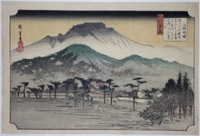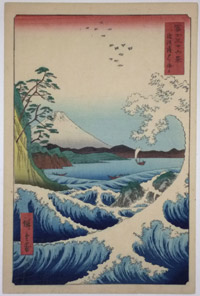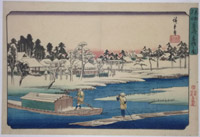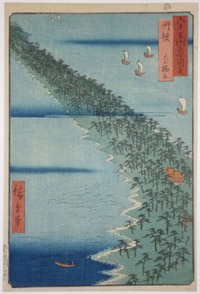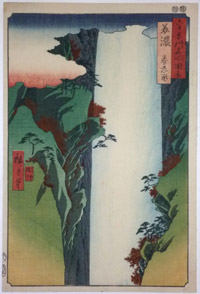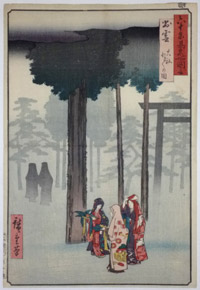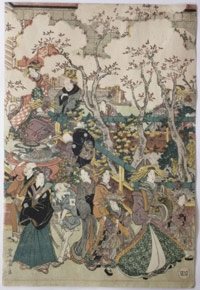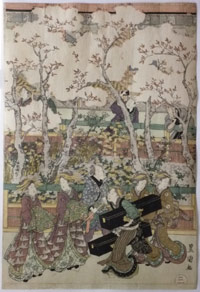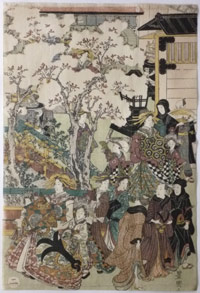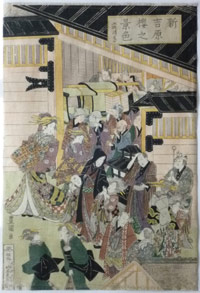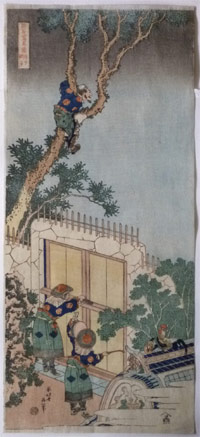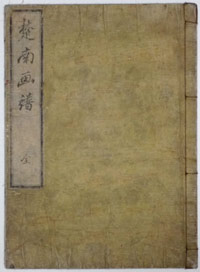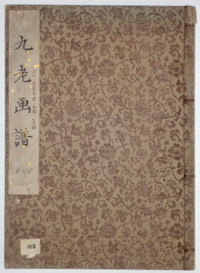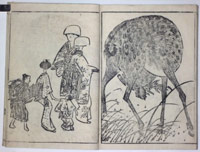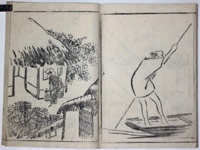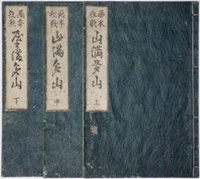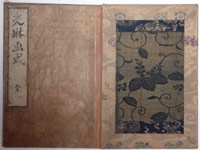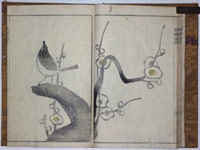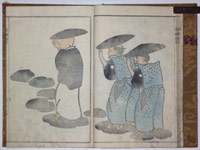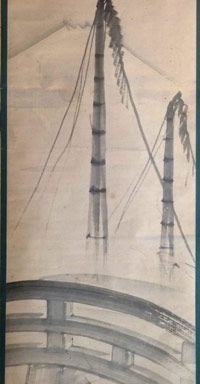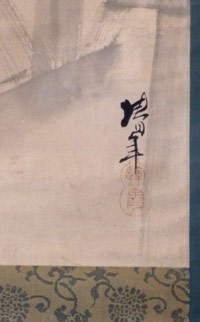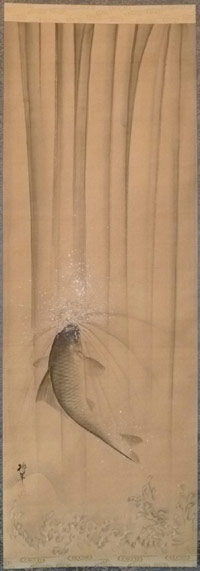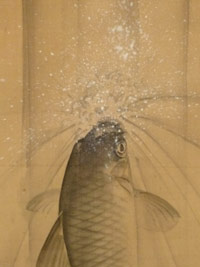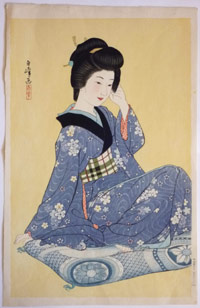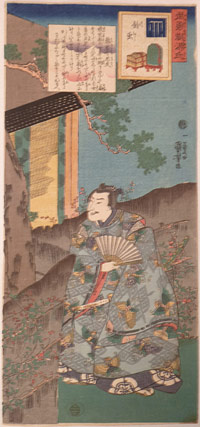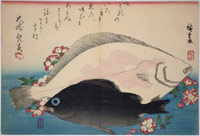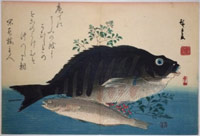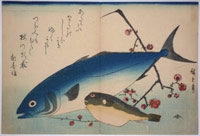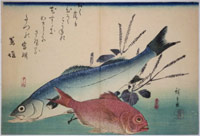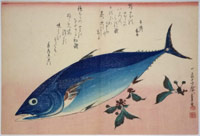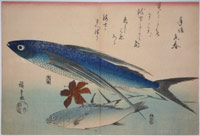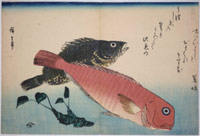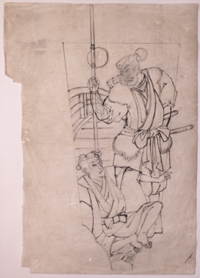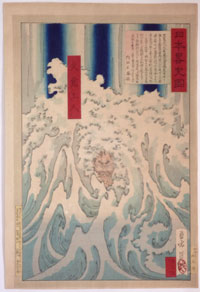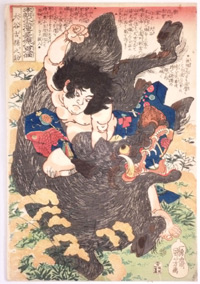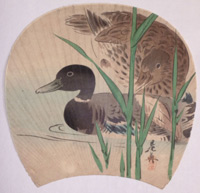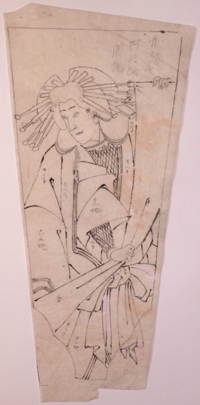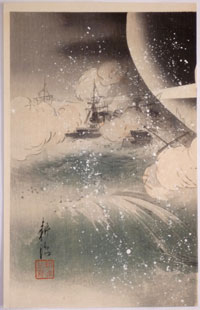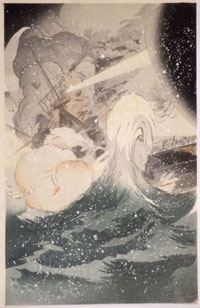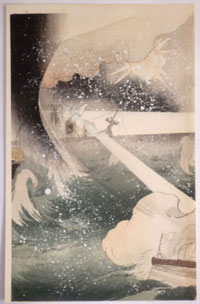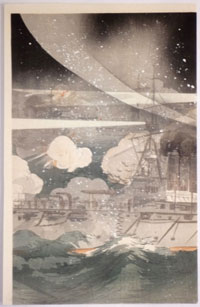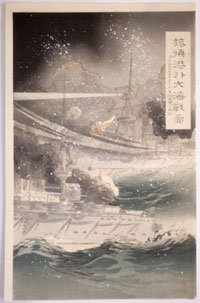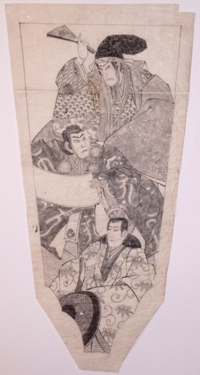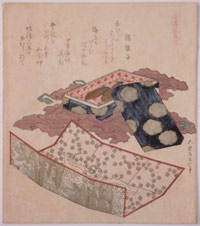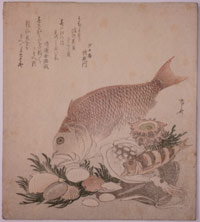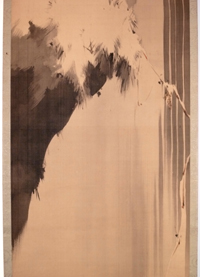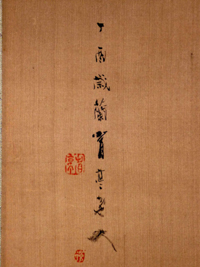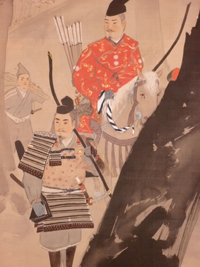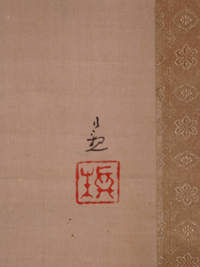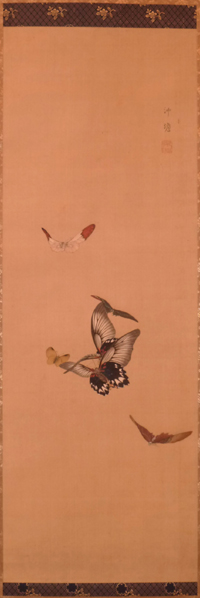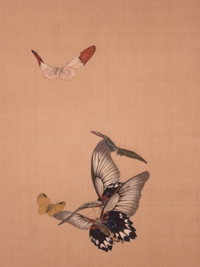/category/archive/page/34/
Ichiryusai HIROSHIGE (1797-1858)
Click here to view image full size.
Evening Bell at Miidera Temple, Mii no bansho, from the set: Omi hakkei no uchi, “Eight Views in Omi Province.” The series of eight prints was published by Hoeido and Eikyudo, c.1834-5. When first published it was advertised as a “work in black and white, lightly coloured,” and Hiroshige was never to surpass the ethereal quality that these figureless landscapes possess. The theme “Eight Views” was borrowed from Chinese poetry and each print conveys pictorially the poem written in the square label at the top right. Beside it, in a red label, is the series title. The designs for the set are known in various states and there are variations in colouring and gradation. Shows the temple hidden in the hills on the southern side of Lake Biwa.
Fine impression. The first edition without the break in the line-block on left next to the row of trees and the break on the lower side of the cartouche containing title. ( Both can be seen on the impression in the Honolulu Academy of Art. ) Fine colour. Minor thinning, otherwise very good condition. Signed Hiroshige ga.
Status: Sold
Ichiryusai HIROSHIGE (1797-1858)
Click here to view image full size.
A giant wave thrown up by the sea at Satta. Suruga Satta kaijo, “Waves Off the Satta Pass in Suruga Province” from the set Fuji sanjurokkei, the “Thirty-six Views of Mount Fuji.” The finest design from the set. The spume of a wave was thought to transmogrify into chidori ( a species of plover ) which can be seen here flying above the sea. Published by Tsutaya Kichizo, 1858. One of Hiroshige’s most popular prints.
Very good impression, colour and condition. Signed Hiroshige ga.
Status: Sold
Ichiryusai HIROSHIGE (1797-1858)
Click here to view image full size.
Masaki yukibare, “Clearing Weather After Snow.” A Toto meisho set of 21 prints published by Kikakudo ( Sanoki ) c 1832-5 and then extended to 55 in c 1839-42. Shows the temple on the far shore with boatmen navigating the river in the foreground. The scene under heavy snow.
Fine impression of the first edition with red Kikakudo seal in right margin ( later editions have the black seal of Sanoki ). Fine colour. Trimmed close on right side. Imperceptible centre fold, otherwise fine condition. Signed Hiroshige ga.
Status: Sold
Ichiryusai HIROSHIGE (1797-1858)
Click here to view image full size.
The Urami Falls, Mt. Nikko, Shimotsuke Province. Shimotsuke, Nikkozan urami no taki. One of the best designs from Rokuju yoshu meisho zue, “Famous Places in the Sixty-Odd Provinces.” The series published by Koshimuraya Heisuke between 7/1853 and 3/1856 ( this being 8/1853 ). The “Back-View” waterfall, so-called because it could be viewed from a path underneath.
Fine early impression with blind-printing on the water. The first edition has the falling water printed blue and other colour variations. ( See Pulverer impression in Rokujuyoshu Meisho Zue, Iwanami Shoten, Tokyo, 1996, no 27. ) However, this is one of those cases where the earliest state is not necessarily the preferred one. Fine colour. Slight edge soil, otherwise very good condition. Signed Hiroshige ga.
Status: Sold
Ichiryusai HIROSHIGE (1797-1858)
Click here to view image full size.
Amanohashidate in Tango Province. One of the best designs from Rokuju yoshu meisho zue, “Famous Places in the Sixty-Odd Provinces.” The series published by Koshimuraya Heisuke between 7/1853 and 3/1856 ( this being 12/1853 ). The sandbank extended about three kilometres into the Sea of Japan. With Miyajima and Matsushima, considered to be one of the three most beautiful spots in Japan..
Fine early impression. The first edition has variations in the clouds. ( See Pulverer impression in Rokujuyoshu Meisho Zue, Iwanami Shoten, Tokyo, 1996, no 38. ) Fine colour and condition. Signed Hiroshige ga.
Status: Sold
Ichiryusai HIROSHIGE (1797-1858)
Click here to view image full size.
The Yoro waterfall in Mino Province. Mino Yoro no taki. One of the best designs from Rokuju yoshu meisho zue, “Famous Places in the Sixty-Odd Provinces.” The series published by Koshimuraya Heisuke between 7/1853 and 3/1856 ( this being 8/1853 ). The fall was also depicted by Hokusai in his set of waterfalls.
Very fine early impression with strong woodgrain and blind-printing on the fall. The first edition has the falling water printed blue and other colour variations. ( See Pulverer impression in Rokujuyoshu Meisho Zue, Iwanami Shoten, Tokyo, 1996, no 23. ) The present state is preferred by some collectors. Fine colour and condition. Signed Hiroshige ga.
Status: Sold
Ichiryusai HIROSHIGE (1797-1858)
Click here to view image full size.
Women bringing offerings to the great shrine in Izumo, Izumo, taisha hotohoto no zue. Hotohoto was a festival on the 14th day of the first month and children went around receiving rice cakes or small amounts of money. One of the best designs from Rokuju yoshu meisho zue, “Famous Places in the Sixty-Odd Provinces.” The series published by Koshimuraya Heisuke between 7/1853 and 3/1856 ( this being 12/1853 ). Izumo is the oldest shrine in Japan in the far south-east of Honshu. The colourful foreground figures contrast with the silhouettes of others and cryptomeria trees receding into the mist.
Fine early impression with nice wiped bokashi across the foreground ( missing on later editions ). The first edition has gradation on the gowns of two of the figures and the trees are hardly visible. ( See Pulverer impression in Rokujuyoshu Meisho Zue, Iwanami Shoten, Tokyo, 1996, no 42. ) Fine colour. Imperceptible centre fold. Very good condition. Signed Ichiryusai Hiroshige ga.
Status: Sold
Utagawa TOYOKUNI I (1769-1825)
Click here to view image full size.
An extremely rare complete pentatych ( each sheet numbered at the bottom ): Shin Yoshiwara sakura no keshiki, “Cherry Blossom in the Yoshiwara.” A panorama of the main Nakanocho street in early April with transplanted cherry trees. The main entrance to the right on the first sheet, the other sheets showing a multitude of courtesans, kamuro, shinzo manservants and customers. A fascinating design with a multiplicity of small vignettes. Cherry blossom was used as a euphemism for the quickly fading beauty of the courtesan. Published c 1810 by Yamatoya Kyubei.
Very good impression; very good colour. Slight horizontal line near bottom edge and slight thinning otherwise very good condition. Signed Toyokuni ga on each sheet.
Status: Sold
Katsushika HOKUSAI (1760-1849)
Click here to view image full size.
Sei Shonagon ( lady of honour to the empress at the court of Ichijo-tenno [ 10th century ]. Rival of Murasaki Shikibu ) from a rare set of ten nagaban prints with title: Shiika shashin-kyo, “A Mirror of Chinese/Japanese Verse.” The set published 1833-4 by Moriya Jihei. The print depicts a story from Chinese lore whereby a loyal follower of a prince who is pursued to the closed frontier gate of Kankoku climbs a tree to imitate the early morning cock-crow, the signal to have the gate opened. Chinese soldiers are at the gate and a cockerel sits nearby.
Fine impression, colour and condition. Completely untrimmed: A rarity with these designs for obvious reasons. Signed Zen Hokusai Iitsu hitsu.
Status: Sold
Onishi CHINNEN (1792-1851)
Click here to view image full size.
A highly talented artist, he is considered – with Nanrei – to be the finest exponent of the Maruyama-Shijo style in Edo at this time. Of samurai birth, he initially studied under Nangaku. See elsewhere on this site for two original paintings by Chinnen. One volume complete Sonan gafu, “Album of Sonan” ( a go of Chinnen ). Published 1834. 6 pp. preface signed and dated Tenpo 3 ( 1832 ); 1p. contents; 26 sheets illustrations in colour. Last page colophon with date Tenpo, year of the Dragon 9/1832 and annotation in sumi with seal: Renkado Ichiyo zo, “From the collection of Ichiyo.” Inside back cover date Tenpo 5 1/1834 and publishers Osakaya Gembei and Kobayashi Shimbei of Edo.
Yellow covers with cross-hatched embossing and original title slip. Some slight soil throughout, otherwise a nice copy of Chinnen’s masterpiece.
Status: Sold
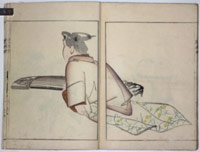
Click here to view image full size.

Click here to view image full size.
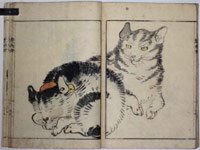
Click here to view image full size.
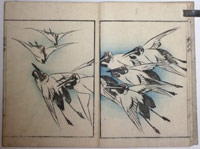
Click here to view image full size.
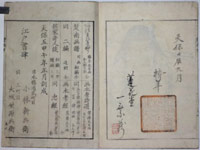
Click here to view image full size.
Ki BAITEI (1774-1810)
Click here to view image full size.
One volume complete: Kyuro gafu, “Kyuro’s Picture Album.” ( Kyuro was one of the art-names of Baitei, a Nanga painter in the Buson manner. ) The first edition of this book is in two volumes with haiku, c 1795. However, there is some confusion on the other issues: Mitchell, Biobibliography Of Nanga, Maruyama, Shijo Illustrated Books, pages 402-4, lists three examples: “A” ( 2 vol. 1795 ); “B” ( 2 vol. 1799 ), and “C” ( 1 vol. 1797 ). The example offered here does not tally with either of these having preface of 2 pp. with 64 single-page illustrations plus 2 pp. afterward and colophon dated Kansai 11 ( 1799 ) published by Koto Shorin. There are also examples with 62 pp. of illustrations and some lacking forward and or afterward and colophon. A later edition of 1824 is also known. A famous book with impressive, bold and austere images.
Lacking original covers and title slip and with some offsetting, but generally a nice copy. Ex Bing collection. In chitsu.
Status: Sold
Katsushika HOKUSAI (1760-1849)
Click here to view image full size.
Three volumes complete: Ehon kyoka yama-mata-yama, “Kyoka: Range Upon Range of Mountains.” The fanciful title is based on the fact that the views illustrated are located around Yama-no-te, the higher ground situated in the north and north-western part of Edo. The pictures accompanied by kyoka poems. Vol.1: 12 sheets, 11 illus.; Vol.2: 10 sheets, 11 illus.; Vol.3, 10 sheets, 10 illus. Kyoka selected by Daigentei Sumikata and Benbenkwan Koryu. This is one of Hokusai’s most admired works. Published 1804 by Tsutaya Jusaburo.
Original dark green embossed covers. Original title slips. A very nice clean copy of this famous book. Some slight smudging of pigments and turning of colour on one or two sheets, but otherwise extremely well retained colour, the elusive blue and purple intact.
Status: Sold
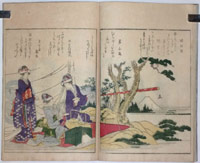
Click here to view image full size.
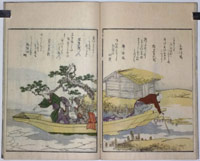
Click here to view image full size.
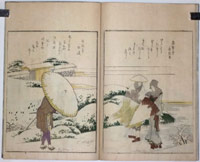
Click here to view image full size.
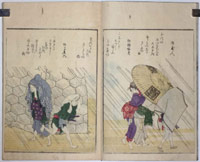
Click here to view image full size.
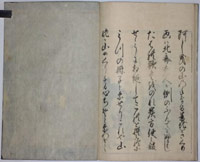
Click here to view image full size.
Aikawa MINWA (? – 1821)
Click here to view image full size.
Korin gashiki, “Drawing Methods of Korin.” One volume complete. Original orange-brown covers with original title slip. Preface dated Bunka 15 ( 1818 ) with 56 pp. of illustrations in light colour. Booksellers: Tsurugaya Kihei ( Osaka ); Kikuya Shichirobei and Kikuya Kihei ( Kyoto ). Ex collections Ulrich Odin, seal bottom right first page ( lot 126, Paris, 1928, ill. pl.V, and Javal ( ref: brocade covered boards ).
Very good impressions. Minor marks with ink smudge on one sheet and two paper repairs on another, otherwise good condition.
Status: Sold
Onishi CHINNEN (1792-1851)
Click here to view image full size.
A highly talented artist, he is considered – with Nanrei – to be the finest exponent of the Maruyama-Shijo style in Edo at this time. Of samurai birth, he initially studied under Nangaku and is famous for the highly regarded books: Azuma no teburi, 1829 and Sonan gafu, 1834 ( offered elsewhere on this site ). Shows Fuji looming above masts and a bridge. Possibly the Inari Bridge near the harbour ( shrine ) at Teppozu in Edo. See Hiroshige’s design of this view for the 100 Views of Edo, no. 77. A typically spontaneous Shijo painting. Sumi on paper. Image size 41 x 10.5 in; 105 x 27 cms. Blue paper mounting; grey-blue damask ichimonji with bamboo rollers. Light creasing otherwise good condition with box. Signed Chinnen with seal Unka.
Status: Sold
Onishi CHINNEN (1792-1851)
Click here to view image full size.
A highly talented artist, he is considered – with Nanrei – to be the finest exponent of the Maruyama-Shijo style in Edo at this time. Of samurai birth, he initially studied under Nangaku and is famous for the highly regarded books: Azuma no teburi, 1829 and Sonan gafu, 1834 ( offered elsewhere on this site ). Shows a carp climbing a waterfall. A leaping carp is one of the commonest subjects for artists of various schools so as to become almost hackneyed. It takes an individual artist to breath life into the subject. Sumi and very light colour on silk. Image size 39.5 x 19 in; 99.5 x 35.5 cms. Blue-grey damask and beige silk mounting; cream gold damask ichimonji with bone jiku. New box. Light toning otherwise very good condition with splashed gofun around the head of the fish. Signed Chinnen with seal Unka.
Status: Sold
Hirano HAKUHO (1879-1957)
Click here to view image full size.
Wakai onna, Young Girl, published by Watanabe Shozaburo, c. 1936. Illustrated in The Female Image, Abe Publishing Ltd., 2000, no. 211, p. 154.
Fine impression and colour. Minor crease bottom right corner, otherwise very good condition. Signed Hakuho ga.
Status: Sold
Utagawa KUNIYOSHI (1797-1861)
Click here to view image full size.
An unfinished otanzaku set Buyu nazorae Genji, “Selected Warriors for the Chapters of Genji.” This design illustrating Chapter 38 ( Suzumushi ) of the Genji monogatari ( the Genji crest in the middle upper right cartouche ). Shows Satsuma Taira Tadanori in court dress with open fan at the door of the house of Kiku-no-mae of the Miyabara family. Published by Ibaya Sensaburo, c 1846. Robinson S28.38.
Fine impression, colour and condition. A slightly later and trimmed copy illustrated in Heroes & Ghosts, 1998, no. 44, p. 70. Signed Ichiyusai Kuniyoshi ga.
Status: Sold
Utagawa HIROSHIGE (1787-1858)
Click here to view image full size.
Hirame, olive halibut ( Paralichthys olivaceus ) and mebaru, black rock-fish ( Sebastes schlegeli ). Together with cherry blossom. Poem by Osaki Koharu. From the second series of nine fish prints published c 1840 – 42 by Yamasho ( Yamadoya Shobei ). Ex collection Felix Bracquemond ( 1833 – 1914 ). Japonisme in France usually starts with Bracquemond who was a graphic artist and designer and also worked with ceramics. He discovered Hokusai’s Manga in 1856 and used it as source material. He produced a number of etchings, often of birds and some with fish, obviously partly inspired by Japanese prints, including Hiroshige’s prints. So, it’s reasonable to suppose these were the actual prints he used as inspiration. Bracquemond’s initial: “B” accompanied the prints.
Very good impression, colour and condition. Centre fold as per usual. Signed Hiroshige ga.
Status: Sold
Utagawa HIROSHIGE (1787-1858)
Click here to view image full size.
Shimadai, a grouper ( probably Chilodactylus zonatus ) and ainame, greenling ( Hexagrammus otakii ). Together with red-berried nanten. Poem by Kanshunro Nushibito. From the second series of nine fish prints published c 1840 – 42 by Yamasho ( Yamadoya Shobei ). Ex collection Felix Bracquemond ( 1833 – 1914 ). Japonisme in France usually starts with Bracquemond who was a graphic artist and designer and also worked with ceramics. He discovered Hokusai’s Manga in 1856 and used it as source material. He produced a number of etchings, often of birds and some with fish, obviously partly inspired by Japanese prints, including Hiroshige’s prints. So, it’s reasonable to suppose these were the actual prints he used as inspiration. Bracquemond’s initial: “B” accompanied the prints.
Very good impression, colour and condition. Centre fold as per usual. Signed Hiroshige ga.
Status: Sold
Utagawa HIROSHIGE (1787-1858)
Click here to view image full size.
Akodai, the rock-fish. ( Sebastes matsubarae ). Known as the medetai, good-luck fish. Together with bamboo grass. Poem by Suzugaki. From the second series of nine fish prints published c 1840 – 42 by Yamasho ( Yamadoya Shobei ). Ex collection Felix Bracquemond ( 1833 – 1914 ). Japonisme in France usually starts with Bracquemond who was a graphic artist and designer and also worked with ceramics. He discovered Hokusai’s Manga in 1856 and used it as source material. He produced a number of etchings, often of birds and some with fish, obviously partly inspired by Japanese prints, including Hiroshige’s prints. So, it’s reasonable to suppose these were the actual prints he used as inspiration. Bracquemond’s initial: “B” accompanied the prints.
Very good impression, colour and condition. Centre fold as per usual. Signed Hiroshige hitsu.
Status: Sold
Utagawa HIROSHIGE (1787-1858)
Click here to view image full size.
Inada, yellowtail or amberjack ( Seriola quinqueradiata ) and fugu, blowfish or puffer ( Fugu pardalis ). Together with plum blossom. Poem by Suzugaki. From the second series of nine fish prints published c 1840 – 42 by Yamasho ( Yamadoya Shobei ). Ex collection Felix Bracquemond ( 1833 – 1914 ). Japonisme in France usually starts with Bracquemond who was a graphic artist and designer and also worked with ceramics. He discovered Hokusai’s Manga in 1856 and used it as source material. He produced a number of etchings, often of birds and some with fish, obviously partly inspired by Japanese prints, including Hiroshige’s prints. So, it’s reasonable to suppose these were the actual prints he used as inspiration. Bracquemond’s initial: “B” accompanied the prints.
Very good impression, colour and condition. Centre fold as per usual. Signed Hiroshige hitsu.
Status: Sold
Utagawa HIROSHIGE (1787-1858)
Click here to view image full size.
Suzuki, Japanese sea perch ( Lateolabrax japonicus ) and kaneme-tai, red bream ( possibly Beryx splendens ). With shiso or beefsteak plant. Poem by Atsugaki. From the second series of nine fish prints published c 1840 – 42 by Yamasho ( Yamadoya Shobei ). Ex collection Felix Bracquemond ( 1833 – 1914 ). Japonisme in France usually starts with Bracquemond who was a graphic artist and designer and also worked with ceramics. He discovered Hokusai’s Manga in 1856 and used it as source material. He produced a number of etchings, often of birds and some with fish, obviously partly inspired by Japanese prints, including Hiroshige’s prints. So, it’s reasonable to suppose these were the actual prints he used as inspiration. Bracquemond’s initial: “B” accompanied the prints.
Very good impression, colour and condition. Centre fold as per usual. Signed Hiroshige ga.
Status: Sold
Utagawa HIROSHIGE (1787-1858)
Click here to view image full size.
Katsuo, bonito ( Katsuwonus pelamis ). Also called ocean bonito, stripe-bellied bonito and striped tuna. Together with three sprigs of cherry ( sakura ). Poems by Toshinoto Haruki and Toshihiro Machikado. From the first series of eleven fish prints published c 1840 – 42 by Yamasho ( Yamadoya Shobei ). Ex collection Felix Bracquemond ( 1833 – 1914 ). Japonisme in France usually starts with Bracquemond who was a graphic artist and designer and also worked with ceramics. He discovered Hokusai’s Manga in 1856 and used it as source material. He produced a number of etchings, often of birds and some with fish, obviously partly inspired by Japanese prints, including Hiroshige’s prints. So, it’s reasonable to suppose these were the actual prints he used as inspiration. Bracquemond’s initial: “B” accompanied the prints.
Very good impression, colour and condition. Centre fold as per usual. Signed Hiroshige ga.
Status: Sold
Utagawa HIROSHIGE (1787-1858)
Click here to view image full size.
Tobiuo, flying fish ( probably Prognichthys ) and ishimochi also called guchi or shiroguchi, white croaker ( probably Argyrosomus argenatus ). Together with a single lily. Poem by Toshigaki Maharu. From the second series of nine fish prints published c 1840 – 42 by Yamasho ( Yamadoya Shobei ). Ex collection Felix Bracquemond ( 1833 – 1914 ). Japonisme in France usually starts with Bracquemond who was a graphic artist and designer and also worked with ceramics. He discovered Hokusai’s Manga in 1856 and used it as source material. He produced a number of etchings, often of birds and some with fish, obviously partly inspired by Japanese prints, including Hiroshige’s prints. So, it’s reasonable to suppose these were the actual prints he used as inspiration. Bracquemond’s initial: “B” accompanied the prints.
Very good impression, colour and condition. Centre fold as per usual. Signed Hiroshige ga.
Status: Sold
Utagawa HIROSHIGE (1787-1858)
Click here to view image full size.
Shiroamadai, white horsehead ( Latilus argentatus ) and omonhata, rock cod ( Epinephalus areolatus ). Together with Japanese horse radish, wasabi. Poem by Atsugaki. From the second series of nine fish prints published c 1840 – 42 by Yamasho ( Yamadoya Shobei ). Ex collection Felix Bracquemond ( 1833 – 1914 ). Japonisme in France usually starts with Bracquemond who was a graphic artist and designer and also worked with ceramics. He discovered Hokusai’s Manga in 1856 and used it as source material. He produced a number of etchings, often of birds and some with fish, obviously partly inspired by Japanese prints, including Hiroshige’s prints. So, it’s reasonable to suppose these were the actual prints he used as inspiration. Bracquemond’s initial: “B” accompanied the prints.
Very good impression, colour and condition. Centre fold as per usual. Signed Hiroshige hitsu.
Status: Sold
Toyohara KUNICHIKA (1835-1900)
Click here to view image full size.
An original hanshita-e drawing probably showing Benkei and Yoshitsune on Gojo Bridge. Sumi on thin paper, image size 14.5 x 6.25 in, 37 x 16 cms. For a series of designs contained within a hagoita ( wooden paddles used to play the New Year hanetsuki game ). Some creasing.
Status: Sold
Yamazaki TOSHINOBU (1857-1886)
Click here to view image full size.
The best design from Nihon ryakushi zu, “ A Brief History of Japan in Pictures.” Mongaku ( Endo Morito, c. 1120 – 1200 ) subjecting himself to three years penance as a Buddhist monk beneath the waterfall of Mount Nachi in Kii Province. Morito inflicted this punishment on himself because he had inadvertently cut off the head of Kesa Gozen, the wife of the palace guard Watanabe Wataru, with whom he was in love. This subject lends itself to some wonderful designs: See this website for a rare horizontal triptych by Yoshitoshi and a vertical triptych by Kuniyoshi, and there are many single sheets by various artists. Toshinobu was a pupil of Kunisada and then Yoshitoshi. Published by Kanei Heizaburo, 1878.
Very good impression color and condition. Signed Oju Toshinobu.
Status: Sold
Ichiyusai KUNIYOSHI (1797-1861)
Click here to view image full size.
The fifteen year old Otani Furuinosuke killing a wild boar with his bare hands. From the set Honcho Suikoden goyu happyaku-nin no hitori, “ Eight Hundred Heroes of Our Country’s Suikoden, One by One.” A series of fine designs coming after the Tsuzoku Suikoden that was a turning point in Kuniyoshi’s career. Robinson S4a.14. Published by Kaga-ya Kichiyemon, c early 1830s. Many designs from this set reissued by Ibaya Sensaburo, c 1845.
Very good impression. Fine colour and condition. Untrimmed ( a rarity on these designs ). Signed Ichiyusai Kuniyoshi ga.
Status: Sold
Shibata ZESHIN (1807-1891)
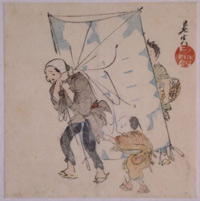
Click here to view image full size.
A rare surimono showing a family going kite flying. The man carrying a huge example on his back.
Very good impression and colour. Minor soil, otherwise good condition. Signed Zeshin with seal.
Status: Sold
Shibata ZESHIN (1807-1891)
Click here to view image full size.
An uchiwa-e showing a pair of mandarin ducks amongst bulrushes. Extremely rare and possibly unique.
Very good impression and colour. The fan has been dismounted from its bamboo frame, hence the rib marks show. Slight soil. Signed Zeshin with Tairyukyo seal ( referring to his home near the Kanda River. Used after 1832 ).
Status: Sold
Ichiryusai HIROSHIGE (1797-1858)
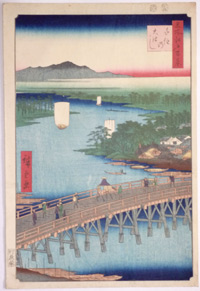
Click here to view image full size.
Senju no Ohashi, “The Senju Great Bridge” from Meisho Edo hyakkei, the “One Hundred Views of Edo” published by Uoei between 1856 and 1858 ( this being 1857 ). The bridge which was built in 1594 connected Edo with Senju ( seen to the right ) over the Sumida ( Arakawa ) River. Ex collection P & L Warnock (seal au verso ).
Very fine impression of the first edition. Minor edge soil otherwise fine colour and condition. Signed Hiroshige ga.
Status: Sold
Ichiryusai HIROSHIGE (1797-1858)
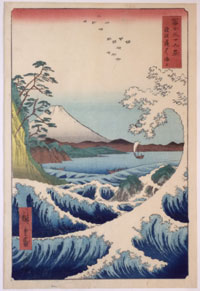
Click here to view image full size.
A giant wave thrown up by the sea at Satta. Suruga Satta kaijo, “Waves Off the Satta Pass in Suruga Province” from the set Fuji sanjurokkei, the “Thirty-six Views of Mount Fuji.” The finest design from the set. The spume of a wave was thought to transmogrify into chidori ( a species of plover ) which can be seen here flying above the sea. Published by Tsutaya Kichizo, 1858.
Very good impression and colour. One slight spot at top, otherwise very good condition. Signed Hiroshige ga.
Status: Sold
Toyohara KUNICHIKA (1835-1900)
Click here to view image full size.
An original hanshita-e drawing showing an actor in an onnagata role. Sumi on thin paper. Image size 12.5 x 6 in, 31.5 x 15 cms. . For a series of designs contained within a hagoita ( wooden paddles used to play the New Year hanetsuki game ). Numerous indications for the printer on the colours to be used. Good condition.
Status: Sold
KOTO (active 1894-1904)

Click here to view image full size.
Little is known of this artist ( whose name can also be read Koshu ), although he seems to have been a pupil of Gekko. A superb 6-sheet design of the great naval battle outside the port of Ryojun ( Port Arthur ). Ryojunkogai daikaisen zu. Shows the attack by Admiral Togo Heihachiro on the Russian destroyers on the night of the 8-9th February 1904. The Russian Vice Admiral Oskar Starks had three vessels hit by Japanese torpedoes. War was declared between Japan and Russia on the 10th February 1904. Published by Heikichi Kimura 1904. The finest design of this genre and period when the publishers had to produce speedy propaganda prints, quickly superseded by photographic processes. Shows the powerful searchlights raking the waves and vessels cleverly tying the six sheets together.
Very fine impression with extensive splashed gofun. Fine colour and condition. Signed Koto.
Status: Sold
Toyohara KUNICHIKA (1835-1900)
Click here to view image full size.
An original hanshita-e drawing showing three actors in various roles. Sumi on thin paper. Image size 12.5 x 6 in, 31.5 x 15 cms. For a series of designs contained within a hagoita ( wooden paddles used to play the New Year hanetsuki game ). Paper separated at top, otherwise good condition.
Status: Sold
Katsushika HOKUSAI (1760-1849)
Click here to view image full size.
Kaiba, Sea Horses, from a series of at least thirty surimono issued for the Yomo-gawa poetry group. Uma zukushi, “Horse Series” was commissioned for the Horse Year 1822 and each design alludes to the word horse. Here the dried sea horses are shown lying in a gold-lacquer folder beside a black-lacquer box containing a pair of beetles ( with connotations of potency ). This set, together with the “Shell Series” issued the previous year, is Hokusai’s most important set. A red hand-stamped title cartouche top right. Unidentified collector’s seal au verso. Rare.
Very fine impression and colour with gauffrage, silver, gold and bronze. Very slight discolouration to the yellow ground, otherwise very good condition. Signed Fusenkyo Iitsu hitsu.
Status: Sold
Ryuryukyo SHINSAI (1764 ?-1820)
Click here to view image full size.
A rare surimono showing a red bream, sea urchin, cuttle-fish, various other molluscs and two unidentified fish with seaweed. Issued c 1810s.
Fine impression with gauffrage. Fine colour and very good condition. Signed Shinsai.
Status: Sold
Watanabe SEITEI (1852-1918)
Click here to view image full size.
An original painting showing a snow covered cliff overhanging a waterfall; one long piece of vegetation is suspended over the fall. A beautiful painting in sumi with light touches of colour on silk. An artist who excelled at kachoga. Image size 39 x 13 in, 99 x 33 cms. Seitei was a successful artist and had a large studio. Many paintings of his are studio or partly studio works. Painting and original (?) mount in good condition. Ivory rollers and wooden box. Fully signed, sealed and dated: Hinoe tori ( 1896 ) doshi, Ran Seitei zu.
Status: Sold
Kobayashi KIYOCHIKA (1847-1915)
Click here to view image full size.
An original painting showing Minamoto Yoshiie, a renowned archer, at the Nakoso checking station ( Kikuta noseki ) on the boundary of the Hitachi and Iwaki Provinces in 1087. He is said to have halted his horse here and composed a waka poem on the cherry blossom covering the path. This well known painting was exhibited at a special exhibition at the Ota Memorial Art Museum in 1989 of Kiyochika’s work and illustrated in the catalogue, no. 193, p.11. Full colour on silk. Image size 50 x 19.5 in, 127 x 49.5 cms. Painting in good condition. Old mount slightly worn top and bottom, but generally good condition. Wooden rollers and box. Signed and sealed Kiyochika.
Status: Sold
Nakabayashi CHIKUTO (1776-1853)
Click here to view image full size.
A technically virtuoso painting of butterflies. Chikuto was recognized as the theorist of the Nanga school and is known for his illustrated books, especially Chikuto gafu of 1800. Full colour on silk. Image size 30.5 x 10.5 in, 77.5 x 26.5 cms. Painting and old mounting in good condition. Ivory rollers and wooden box. Signed and sealed Chikuto.
Status: Sold
